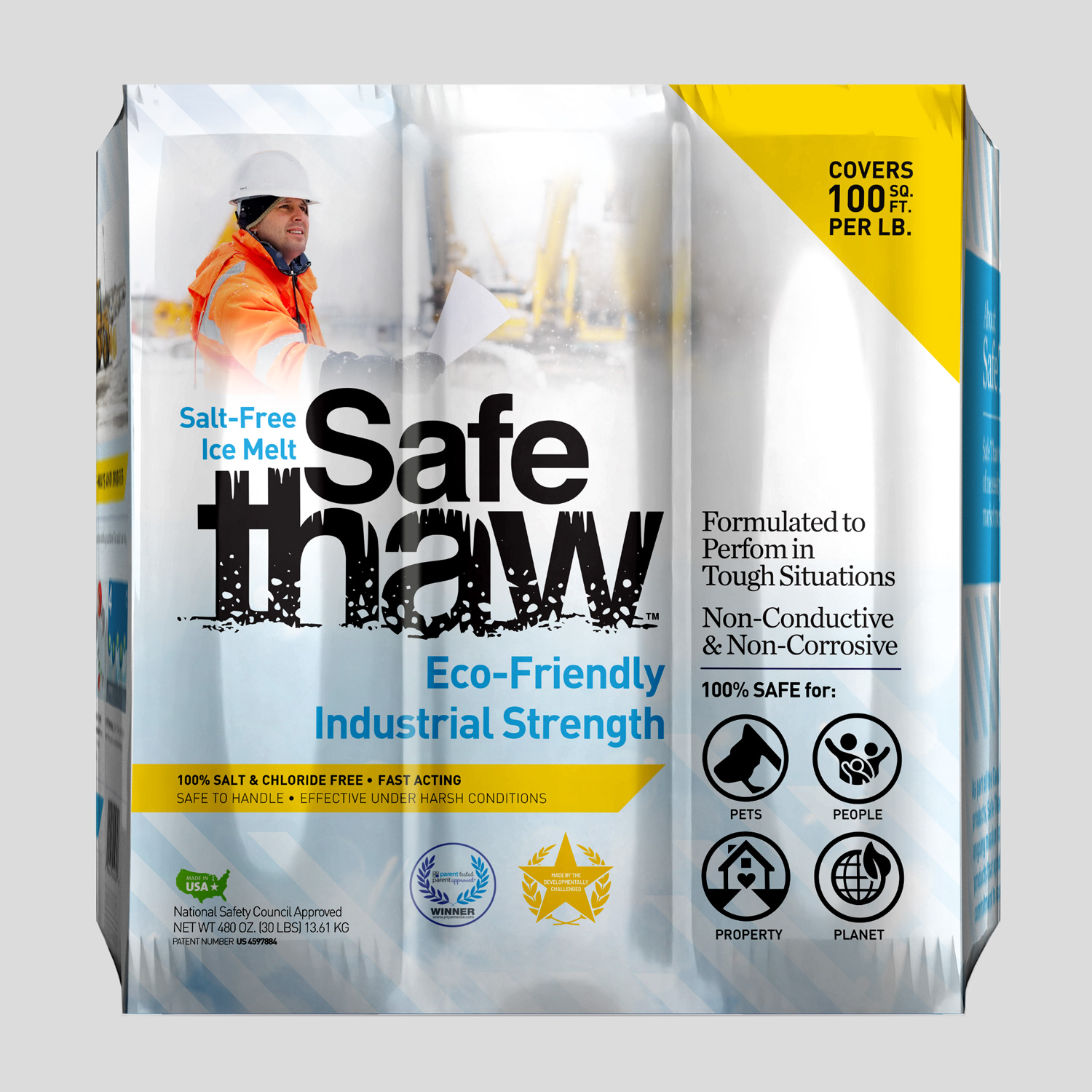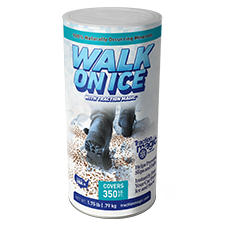At What Temperature Does Salt Stop Melting Ice? A Detailed Exploration Into Its Limitations

Introduction
In battling winter’s icy grip, we often turn to salt, the traditional ice melter. But there comes a point where even salt meets its match. The question is – “at what temperature does salt stop melting ice?” Understanding this limit helps us find more efficient ways of managing winter’s ice and snow.

Safe Thaw
Safe Thaw was created as the ice management solution for tough winter environments. Ideal in commercial and industrial properties, shops, government agencies, bridges, and construction.
The Science Behind Salt And Ice
When salt is applied to ice, it disrupts the freezing process. This happens because salt lowers the freezing point of water, causing the ice to melt at temperatures below 0 degrees Celsius or 32 degrees Fahrenheit, which is water’s normal freezing point.
The Limitations Of Salt
Despite its effectiveness in certain temperature ranges, salt has its limitations. It begins to lose its ability to melt ice when the temperature drops below -9 degrees Celsius or 15 degrees Fahrenheit. This means in extremely cold conditions, using salt becomes less efficient.
Not only that, but salt’s ice melting efficiency also hinges on the time factor. The question, “how long does it take for salt to melt ice?” is another critical point to consider. The reaction speed of salt on ice is contingent on the temperature and concentration of the salt, meaning that it can sometimes take longer than desirable to see results.
The Drawbacks Of Heating Mats
While heating mats might seem like a reliable alternative to salt, they come with their own set of issues. They are energy-intensive and often require a significant installation process. The costs of running them throughout the winter can also quickly add up, making them an inefficient solution in the long run.
Safe Thaw: The Superior Alternative
Considering the limitations of both salt and heating mats, we need a more efficient and reliable solution. That’s where Safe Thaw comes in.
- Safe Chemistry: Safe Thaw utilizes a patented dual-effect formula that breaks the surface tension and melts ice instantly, speeding up the melting process. This makes it more efficient than traditional salt, even in extremely cold temperatures.
- 100% People, Pet & Plant Safe: Unlike salt, Safe Thaw is 100% salt-free and safe for eyes, skin, and paws. It’s also safe even if ingested, ensuring an all-around safer environment for everyone.
- Surface Safe: Safe Thaw doesn’t harm your property. It’s 100% safe on all surfaces, including decking, at least 1-year-old concrete, pavers, brick, stone, etc., providing homeowners peace of mind during the icy months.
- Non-Corrosive & Non-Conductive: Safe Thaw does no damage to delicate machinery and won’t short circuit expensive equipment, unlike salt, which is corrosive and can cause extensive damage.
Ice Melt Temperature: Why It Matters More Than You Think
Now that we’ve explored where salt falls short, it’s natural to wonder—how much does ice melt temperature really matter when choosing a deicer? The answer is: a lot more than most people realize. Ice doesn’t behave the same way at every temperature. At 25°F, you may still see salt slowly working. But once the thermometer slides down toward 15°F or lower, you’ll notice that melting practically stalls out.
That’s why people often say, “What temperature does salt stop working on roads?” The reality is, below about 15°F, rock salt struggles to break the bond between ice and pavement. And when you go down to single digits or even subzero conditions, that bag of rock salt in the garage becomes almost useless. The ice simply wins the battle.
Safe Thaw is designed to sidestep this temperature limitation. Because of its unique formula, it doesn’t depend on a narrow ice melt temperature range. Instead, it continues to work effectively far below the threshold where rock salt gives up. That means fewer patches of dangerous black ice, less time waiting for results, and more confidence during severe cold snaps.
What Temp Does Rock Salt Stop Working, and Why It’s a Problem
You may have heard varying answers when asking, “What temp does rock salt stop working?” Some say 20°F, others insist it’s closer to 15°F. Both are technically correct depending on moisture, traffic, and application rate. But the bottom line is that once temperatures dip below that range, rock salt isn’t melting ice—it’s just sitting there.
The problem with relying on rock salt in extreme cold is that it creates a false sense of security. You may see grains scattered across your driveway or road, but the ice underneath is as slick as ever. That’s where accidents happen—cars skid, pedestrians slip, and concrete surfaces begin to take damage from both freeze-thaw cycles and corrosive salt residue.
Compare that to Safe Thaw, which maintains performance even when winter unleashes its harshest blows. Instead of relying on a chemical reaction that stalls out at low temperatures, it penetrates the surface of the ice, breaking the bond more quickly. For anyone who’s watched salt struggle while the mercury drops, this difference is a game-changer.
Best Temperature for Concrete to Cure and Why Deicers Matter
Here’s another angle people often forget: concrete itself has a temperature “sweet spot.” The best temperature for concrete to cure is between 50°F and 70°F. In that range, curing is steady and strong, giving you durable, long-lasting surfaces. But when you pour concrete late in the season—or use harsh salts afterward—you set it up for early damage.
If concrete freezes before it cures, the water inside expands, weakening the structure. Add corrosive rock salt to the mix, and you speed up cracking, scaling, and surface spalling. That’s why chloride-based salts are such a problem for new driveways, walkways, and patios.
Safe Thaw, on the other hand, is engineered to be surface-safe. Whether your concrete is fully cured or just over a year old, it won’t eat away at the surface or seep into pores, preventing the premature breakdown that plagues so many salt-treated properties.
Real-World Winter Scenarios: Roads, Driveways, and Beyond
Let’s play out a common situation. Imagine you’re driving home during a cold snap. The city spread salt earlier in the day, but now temperatures have dropped to 10°F. What happens? Despite the white crystals on the road, the surface remains icy because the ice melt temperature threshold has been crossed. That’s why you’ll often hear reports of accidents even after road crews have “treated” highways. The salt is physically present, but chemically inactive.
Homeowners face the same frustration. You may shovel, sprinkle rock salt, and wait—only to discover your walkway is still slick hours later. It’s not that you didn’t apply enough. It’s that the salt can’t function at that temperature. The result? More reapplications, more wasted product, and still no reliable safety.
Why Safe Alternatives Are the Future of Ice Control
When you add up the limitations of rock salt—its narrow ice melt temperature range, corrosive impact on concrete, and inability to perform in extreme cold—the conclusion becomes clear. The future of ice management isn’t about pushing more salt onto roads and driveways. It’s about smarter solutions.
Safe Thaw’s ability to stay active at temperatures where salt fails makes it more than just another product on the shelf. It’s a reliable, people- and pet-safe option that reduces long-term damage while keeping surfaces slip-free. And in a world where budgets matter, using less product for better results makes sense both financially and environmentally.
100% salt & chloride-free, fast acting Ice Management Solution
Conclusion
So, to bring it full circle: knowing the ice melt temperature limits of salt helps explain why winter safety so often feels like a losing battle. You now know the answer to questions like “what temperature does salt stop working on roads?” and “what temp does rock salt stop working?”—and the truth is, salt simply can’t handle the coldest conditions. Add to that the importance of the best temperature for concrete to cure, and it’s easy to see why pouring salt over fresh or vulnerable concrete is a recipe for disaster.
The smarter move? Choosing a non-corrosive, chloride-free product like Safe Thaw that continues to perform when traditional options fail. It’s safer for pets, plants, people, and property, while also being tough enough to face the coldest nights of the year. Winter may not compromise, but with the right solution, neither do you.
Try Also Our Other Winter Safety Products:
Safe Paw
The Original and #1 Selling Pet and Child Safe Ice Melt for over 20 years. Guaranteed environmentally safe –It won’t harm animals or children, and it won’t damage your property. That’s Safe Paw. Safe Paw can change how winter affects our planet.

Walk On Ice
The handy disposable canister can be taken everywhere, with the same 100% naturally occurring minerals that provide instant traction on ice or snow. Use it on sidewalks, steps, or as an instant traction agent for your car.



